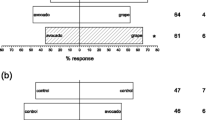Summary.
Host plant volatiles which attract insect herbivores for egg-laying are of principal interest with respect to insect ecology and evolution. Direct applications concern population monitoring and control through behavioural manipulation. Identification of behaviourally active plant secondary metabolites is essential also for plant breeding for insect resistance. Grapevine moth females Lobesia botrana are attracted by upwind flight to green grape berries Vitis vinifera. The headspace of grape berries was collected on air filters. A solvent extract of these filters, released from a sprayer, attracted females in the wind tunnel. The results demonstrate that volatile cues mediate attraction of grapevine moth females to grape berries, and that headspace collections capture the essence of this odour signal. The air filter extracts were examined by gas chromatography coupled with electroantennographic detection, and the compounds eliciting a consistent antennal response in L. botrana females were identified by mass spectrometry. The headspace collection apparatus was calibrated for collection efficiency of the active compounds. Their recovery rate ranged from 35 % for methyl salicylate to 83 % for (E,E)-α-farnesene. A synthetic ten-component blend was then formulated. The blend consisted of compounds eliciting an antennal response, formulated in a blend ratio corrected for differences in collection efficiency. Subsequent wind tunnel tests showed that female attraction to this synthetic ten-component blend was not significantly different from attraction to grape berries, or to headspace collections of the same berries. At a release rate of 35 ng/h of the most abundant compound (E)-β-caryophyllene, 20 % of the test females approached the source of sprayed headspace collections and the ten-component synthetic blend, respectively. In comparison, 100 g of green berries, releasing the main compound (E)-β-caryophyllene at a rate of ca. 4.7 ng/h, attracted 10 % of the females by upwind flight followed by source contact.
Similar content being viewed by others
Author information
Authors and Affiliations
Corresponding author
Rights and permissions
About this article
Cite this article
Tasin, M., Bäckman, AC., Bengtsson, M. et al. Wind tunnel attraction of grapevine moth females, Lobesia Botrana, to natural and artificial grape odour. Chemoecology 16, 87–92 (2006). https://doi.org/10.1007/s00049-005-0332-6
Received:
Accepted:
Published:
Issue Date:
DOI: https://doi.org/10.1007/s00049-005-0332-6




